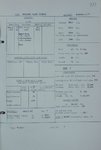OldSkeptic
Senior Airman
- 509
- May 17, 2010
Look again and look at the rib sections in the lower right hand corner. By the time you get to the 4th gun the wing is about 1/2 the thickness it is at the beginning of the wheel well and start of the "normal" leading edge tank.
Even rib 14 (just inboard of the of the 2nd gun) shows a sizable reduction cross section of the leading edge compared to Rib 5.
And here is a link to a photo of the inside of the leading edge.
http://www.vintagewings.ca/Portals/0/Vintage_Stories/News Stories E/Just Wingin' It/Wings10.jpg
Trying to fit large tanks in the leading edge WITH protection is going to be a nightmare.
Perfectly correct, concentrating on outer leading edge tanks is more practical.
Been doing some checking and Boscomb Down cleared the FR XIV for combat with about 15 gals in the rear tank.
Given that Berlin in a XIV is possible, even with just the standard inner leading edge tanks.
One thing I need to find out is that the VIII had 96 gals in the 2 front tanks (the IX had the usual 85 gals) but the XIV reverted to the 85 gals.
Not sure why that was, since the XIV is a VIII with a Griffon, unless there was some sort of issue with space. Any ideas would be useful.



